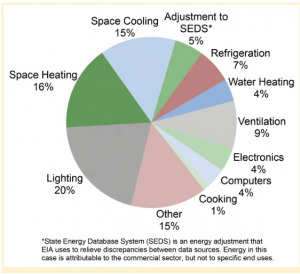You enter your company’s office. It’s a beautiful environment: well-furnished, employees hard at work, bathed in natural light from a wall of windows that you chose specifically to make this a more appealing workplace. People love natural light—not only is it warm and inviting, but it’s also proven to improve mood, productivity, and sleep.
So why isn’t anyone sitting at the workstations by the windows?
You walk over to the area and squint. Leaves that once shielded some of the sunlight now lay on the ground under the trees. Warmth prompts a thought to take off your coat. You could turn down the thermostat… but the energy bill is already a bit of a budget buster.
You’re not alone in this heated dilemma. According to the University of Michigan’s Center for Sustaina
ble Systems, here are a few illuminating data points about resource consumption:
- Commercial buildings consumed 18% of all energy in the U.S. in 2022. (EIA)
- Solar heat gain through windows is responsible for roughly one-third of a building’s cooling load. (DOE, p. 3)
- 15% of the commercial sector’s energy was used for space cooling. (DOE)
 The U.S. is addressing carbon emissions and confronting the challenges of decarbonizing the grid. In light of the data, it is not surprising that legislators are targeting commercial buildings by prioritizing net zero energy buildings. In their pursuit to regulate and reduce carbon emissions, carbon taxes on commercial buildings are gaining momentum, with New York City and Washington D.C. being the first. How disruptive would it be to your business if your residing state is next?
The U.S. is addressing carbon emissions and confronting the challenges of decarbonizing the grid. In light of the data, it is not surprising that legislators are targeting commercial buildings by prioritizing net zero energy buildings. In their pursuit to regulate and reduce carbon emissions, carbon taxes on commercial buildings are gaining momentum, with New York City and Washington D.C. being the first. How disruptive would it be to your business if your residing state is next?
Whether responding to social pressures or their own personal convictions, business owners are setting goals and taking action to reduce their environmental impact and improve their ESG performance. Here, we will highlight an often overlooked and underestimated ESG solution that builds into all three pillars: solar control window films.
What Is ESG?
ESG, which stands for environmental, social, and governance, is a framework for evaluating the sustainability of companies, specifically for investors. As the importance of sustainability and ESG performance has extended beyond investors to consumers and owners, the framework also helps companies to begood stewards of their natural and social capital.
ESG concerns vary by sectors of the economy, a variance called “materiality,” where companies report on ESG issues that are considered financially material to their given industry. Financial material issues impact a company’s financial performance, such as surplus costs.
The first pillar—environmental—focuses on emissions, recyclable resources, water efficiency, land use, and positive sustainability impacts. In the case of commercial property and business owners, how a company outfits its commercial building significantly impacts the sustainability of the organization and the surrounding community.
The UN World Commission on Environment and Development, most commonly quoted for the definition of sustainability, maintains that developments should “meet the needs of the present without compromising the ability of future generations to meet their own needs.” Essentially, sustainability presumes that resources are finite, and every business owner and property manager should manage those resources responsibly.
Companies set ESG goals for several reasons, some of which include to
- Communicate their commitments
- Further their corporate sustainability strategies
- Meet stakeholder expectations
- Improve operational and financial performance
Sustainable Solutions
To achieve goals like those listed above, businesses must align their goals with ESG initiatives and action plans. The UCLA Sustainability Committee suggests achieving environmental health, social equity, and economic vitality requires a systems approach.
One method is renewable energy systems design, which relies on implementing renewable energy sources into a building. Renewable energy systems, like highly efficient solar energy systems, minimize the use of toxic fossil fuels. The National Renewable Energy Laboratory (NREL) found that 62% of office buildings, or 47% of commercial floor space, can reach net-zero energy use by implementing current energy efficiency technologies and outfitting buildings with solar photovoltaic (solar PV) technologies.
While that may sound complex and costly, one simple and economical retrofit option is applying solar control window film to existing windows. Modern, high-performance window films reflect excessive sunlight whileallowing for adequate external visibility and natural interior illumination.
Benefits of Solar Window Films
Let’s start with the financial benefits. Window film can help to significantly reduce energy costs, and is a more cost-efficient option than replacing windows entirely. Does your utility company have a separate, additional charge based on the highest monthly rate of electricity use? Most do. You can reduce demand charges by reducing the amount of cooling you need during peak periods. Some utilities and states also offer rebates and other incentives for installing window film because of its ability to help save energy.
Solar window films also offer the following benefits, which support the goals of ESG:
- Block up to 99% of the sun’s harmful ultraviolet rays, protecting people and furnishings from sun damage
- Minimize heat admittance, providing a cooler workplace interior
- Maintain the efficiency of HVAC systems, extending the system’s life and better regulating temperatures
- Lower electricity and maintenance bills, reducing financial waste
- Boost employee productivity and engagement, retaining top talent and optimizing customer satisfaction
If you are seeking LEED certification, window films can apply to the intent of certain LEED credits.
Read more about how solar window films protect people and property here.
How Do Solar Window Films Work?
Not to get too technical, but for those who are wondering how exactly solar control window film works, here is a quick scenario. When sunrays hit a window, the window reflects some of it and absorbs some, too, but most transmits through the glass. When this energy invades a workspace, it adds to the existing heat of the people, mechanics, furniture, and carpeting. Unregulated, this combination creates an uncomfortable work environment for your people and energy bill. Solar control window film makes your existing windows more efficient byincreasing the amount of solar energy, both reflected and absorbed.
Protect it. Enhance it. Worth it.
If you own or maintain a commercial property and lead a team of people, you have valuable resources that you want to protect and enhance. As with most products, not all window film is created equally, and it requires certain skills to install for its intended effectiveness. We know the best quality manufacturers, offer expertise to select the right solution that aligns with your goals, and bring mastery to install it right. Our team can help you protect your people and property and enhance your bottom line—and while doing it.


